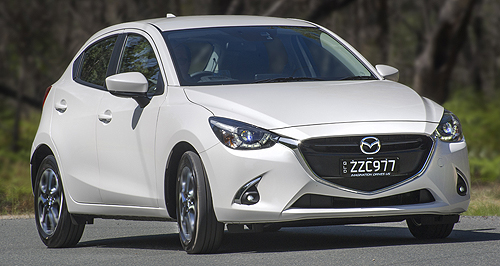New models - Mazda - Mazda2Driven: Mazda updates and expands Mazda22 styles: The updated Mazda2 adds a new, top-spec GT variant and will be sold in hatch and sedan body styles in all variants bar the Genki, which will be a hatch-only affair. Boosted safety tech, improved handling and driveaway pricing for updated Mazda212 Apr 2017 12:20pmMAZDA has updated its diminutive Mazda2 hatch and sedan range, bringing new active safety technology, G-Vectoring control and a new range-topping GT variant, while retaining the pricing of the pre-update model. The point of entry to the Mazda2 range still remains the six-speed manual Neo hatch and sedan priced at $14,990 before on-roads with driveaway pricing adding another $2000, while the highest asking price is $23,680 for the six-speed automatic GT. The Honda Jazz, Holden Barina and the sales-leading Hyundai Accent are also offered for $14,990 before on-road costs, undercut in the light car segment only by the Suzuki Swift which retails for $14,990 driveaway. Many of the Mazda2’s changes have been made under the skin, including the addition of a number of active safety features, such as the ‘Smart City Brake Support – Forward’ collision mitigation system that is now standard across the range. Rear collision mitigation is now standard on all variants bar the base Neo, while blind spot monitoring and rear cross-traffic alert are standard on the higher-spec Genki and GT, and optional on the Neo and Maxx. Mazda’s new G-Vectoring torque control system has now been rolled out across the Mazda2 range, after being introduced in the second half of last year initially on the Mazda3. The G-Vectoring system works by slightly reducing torque input when steering, which causes the vehicle’s nose to dip and more weight being sent to the front wheels, which in turn creates greater handling response and dynamics. Mazda is in the midst of rolling out the G-Vectoring system on all of its models except for the BT-50 pick-up. Further updates have been made to the Mazda2’s ride and handling, including revised suspension bushings, front and rear dampers and electronic power steering recalibration. Noise, vibration and harshness (NVH) levels have been improved with the addition of a noise-insulating windscreen, insulation in the engine compartment, and damping material and insulation in the luggage compartment. Powertrains remain unchanged, with all variants powered by a 1.5-litre naturally aspirated petrol four-cylinder unit that makes 79kW at 6000rpm and 139Nm at 4000prm in base Neo spec, while all other variants get a tiny 2kW/2Nm bump up to 81kW/141Nm. All variants are offered with the choice of a six-speed manual or automatic, with manual fuel economy rated at 5.4 litres per 100km and 5.2L/100km for the Neo and other variants, while the auto produces figures of 5.5L/4.9L/100km. Exterior changes to the new model are minimal, and include folding mirrors across the range with integrated indicators, while Genki and GT hatch variants get silver foglamp bezels and gunmetal coloured grille, as well as a shark fin antenna for hatch variants. The two higher-spec variants also get 16-inch alloys, with different styling for each. Interior changes include a redesigned steering wheel, DAB+ radio for all but the Neo, and head-up display for the Genki and GT. New colour additions include Deep Crimson Mica, Eternal Blue Mica, Meteor Grey Mica and Jet Black Mica. Standard equipment on the base Neo includes 15-inch steel wheels, cloth trim, 60/40 folding rear seats, air-conditioning, cruise control, tilt and reach adjustable steering wheel, Bluetooth, USB and auxiliary capability, keyless push-button start, five airbags, ABS brakes, dynamic stability control and rear parking sensors. Upgrading to the Maxx adds 15-inch alloys, leather-wrapped gear shifter, handbrake and steering wheel, 7.0-inch touchscreen display, six-speaker audio, radio program information and reversing camera. Stepping up to the hatch-only Genki nets buyers 16-inch alloys in gunmetal grey, LED daytime running lights, headlights and foglamps, auto-folding power mirrors, chrome exhaust extension, rain-sensing wipers, climate control air-con, sat-nav, blind spot monitoring and rear cross-traffic alert. Opting for the top-spec GT adds different 16-inch alloys, soft-touch white centre console side panels and armrest panels, and white leather/black cloth seat trim for hatches, and black leather/synthetic suede for sedans. Mazda says it is anticipating about 1000 monthly sales of the new Mazda2, which would put it under the 13,639 sales the car recorded in 2016, due to the declining passenger car segment. Expected sales splits are about 75 per cent hatch to 25 per cent sedan, with four in five buyers predicted to go for an automatic transmission. Mazda will have the Hyundai Accent in its sights, which took the light car segment sales crown from the Mazda in 2016, and is leading the 2017 sales tally with 3810 units compared to the Mazda2’s 3097. 2017 Mazda2 pricing*
 Quick testsRead moreMazda2 pricingMotor industry news |
|
||||||||||||||||||||||||||||||













































Facebook Twitter Instagram